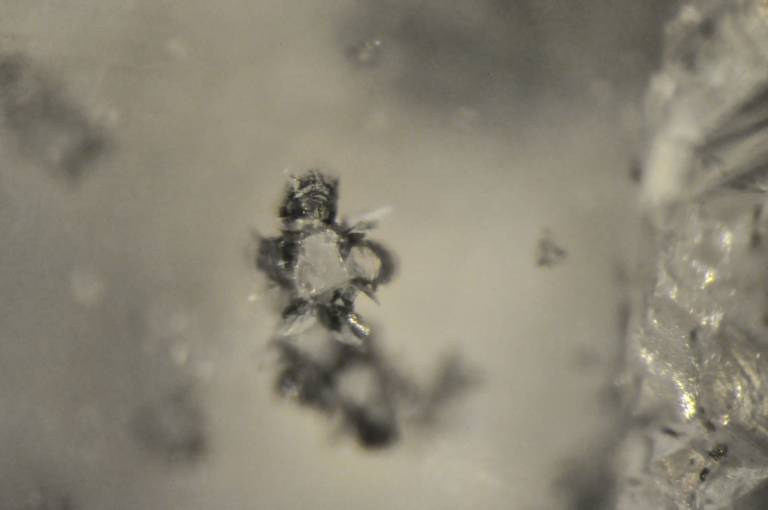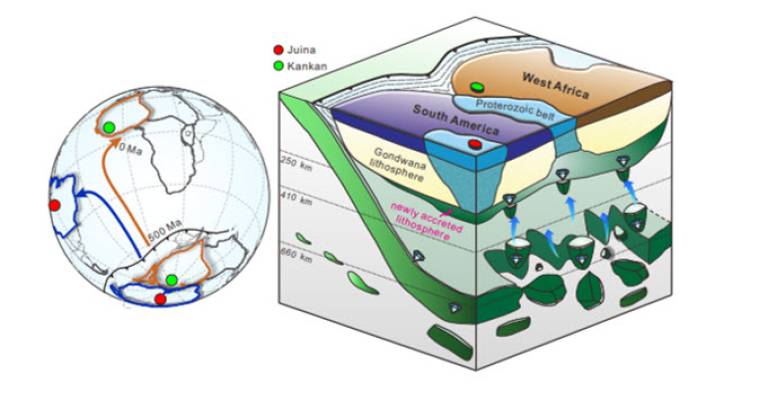Deep diamonds illuminate supercontinent growth
18 October 2023
Superdeep diamonds trace the rise of their buoyant mantle host rocks to the base of the supercontinent Gondwana between 650-450 million years ago, growing and stabilizing the supercontinent keel from below. Finding published in Nature.

Image: Ca-silicate inclusion inside a diamond from Kankan, Guinea. Photo credit: Margo Regier
Continents drift across Earth’s surface and at specific times in geologic history, they become stitched together as “supercontinents”. Later they rift apart and can migrate thousands of kilometers to become assembled anew. Collectively, these migrations are known as the “supercontinent cycle”.
Supercontinents can focus deep oceanic plate subduction – the driver of plate tectonics – in very specific regions. Such deep geologic processes, especially in the past, have been very difficult to study directly because the oceanic crust is young and the continental crust only provides a limited view of Earth’s deep workings. Old diamonds offer a direct window into the deep plate tectonic engine and how it might relate to the supercontinent cycle.
An international team of researchers led by Dr. Suzette Timmerman of the University of Bern, Switzerland, studied the evolution of the Gondwana supercontinent from its bottom. Dr. Timmerman, then a Banting post-doctoral fellow at the University of Alberta, used superdeep diamonds – formed at 300-700 km depth – to trace how material was added to the keel of the supercontinent and recognized a previously unknown geologic process (see Figure).

Figure: Globe showing the initial location of the Gondwana supercontinent ~ 500 million years ago, adjacent to a major subduction zone (black serrated line), followed by the path of continental dispersion to the current locations of Africa (orange) and South America (blue). Block diagram shows the subduction of oceanic plates accompanied by deep diamond formation. The diamond-bearing former plate becomes buoyant, rising in “diapirs” that carry superdeep diamonds to the base of Gondwana, before it disperses. Volcanic rocks called kimberlites erupt the diamonds to Earth’s surface 90 million years ago, providing a unique record of this process. Drawing by Qiwei Zhang.
Tiny silicate and sulphide inclusions inside the diamonds were studied and dated by the team of diamond specialists in laboratories at the University of Alberta, Carnegie Institution for Science, Vrije Universiteit Amsterdam, University of Bristol, and University of Padua, using state-of-the-art analytical techniques capable of analysing picograms (10-12 g) of extracted material.
The geochemical analyses and dating of inclusions in the diamonds, combined with existing plate tectonic models of continent migration, showed that diamonds formed at great depths beneath Gondwana when the supercontinent covered the South Pole, between 650-450 million years ago. The host rocks to the diamonds became buoyant during diamond formation, transporting subducted mantle material plus the diamonds to the base of the root of Gondwana, in essence ‘growing’ the supercontinent from below. Around 120 million years ago, Gondwana started to break apart to form the present oceans such as the Atlantic. At 90 million years ago, the diamonds, carrying trapped tiny inclusions of the host rock, were brought to the Earth’s surface in violent volcanic eruptions. The current locations for these volcanic eruptions are on the continental fragments of Brazil and Western Africa, two of the key components of Gondwana. Thus, the diamonds must have migrated together with different parts of the former supercontinent as it dispersed, “glued” to their base.
This complex history of the diamonds shows that they are remarkably well-travelled, both vertically, and horizontally, within the Earth – tracing both the formation of the supercontinent and the latter stages of its evolution. The accretion of relatively young material to the roots of the continents thickens and “welds together” these ancient continental fragments indicating a potential new mode of continent growth.
Links:
- Timmerman, S., Stachel, T., Koornneef, J.M. et al. Sublithospheric diamond ages and the supercontinent cycle. Nature (2023).
- UCL co-author of this study Dr Andrew Thomson academic profile
 Close
Close

